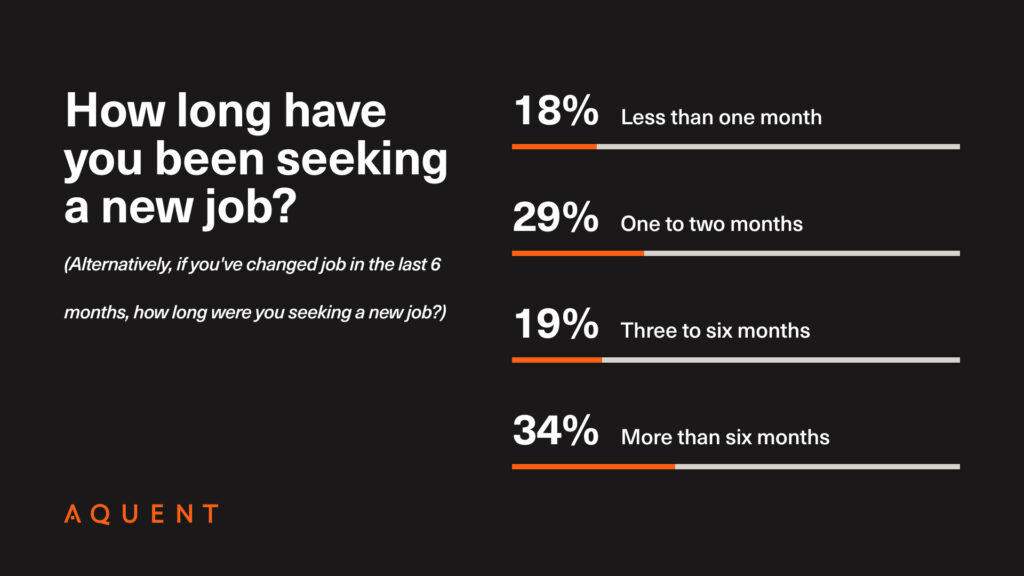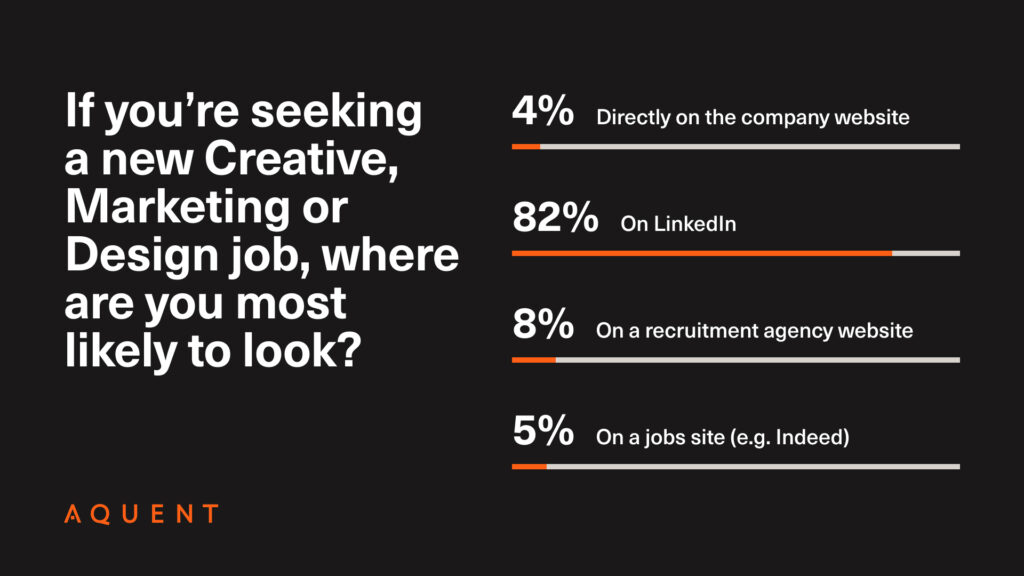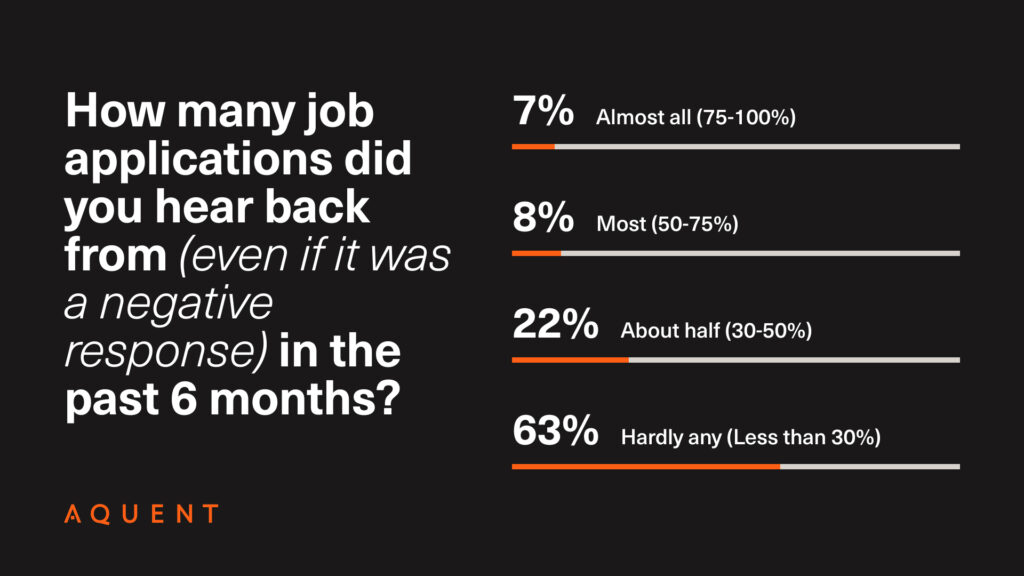Across October and November, Aquent conducted a series of surveys to build on our understanding of the state of the UK job market. Already well aware that a wavering economy was staving off many businesses from making real hiring decisions, instead making do with in-house expertise or – at a push – somebody temporary to lend a hand, what we sought to determine from our 1605 respondents was how organisations were behaving when they were recruiting and what this meant for job seekers.
Gaining a well-rounded understanding of the UK job market is useful both for leaders and hiring managers, but also for those looking to get a job – whether that's the next rung on the ladder, a career change, a graduate or somebody returning to work after some time off. Leaders will be able to look at this and leverage the information from an employer-branding perspective, avoiding pitfalls and pain points that job seekers are experiencing to make their companies more desirable places to work. Job seekers might identify tactics that can help them make the decision when it comes to their next career move, and – if they've been looking for their next opportunity for a while – appreciate a macro-perspective on finding work in the current climate.
53% of job seekers are on the market for more than 3 months.

The first question in our UK job market series asked “How long have you been seeking a new job? (Alternatively, if you've changed job in the last 6 months, how long were you seeking a new job?)”. A staggering 53% of respondents shared that they had been seeking a new opportunity for at least 3 months, with 64% of that group searching for more than 6 months.
In part we can attribute this to fewer openings, drawn out interview periods and slower decision making – all leading to a lot of Talent seeking opportunities that are few and far between. It's worth noting that this wasn't limited to similar job titles as respondents in the 6+ months group held positions like 3D Artist, Senior Content Strategist, Marketing Manager, Senior Software Engineer, UX Designer, Creative Copywriter, Project Coordinator, Business Analyst and Recruitment Coordinator.
Nearly 40% of job seekers apply for 100+ jobs.

Building on the previous point, we know longer job searches directly correlate with a greater number of applications. But just how great, you probably wouldn't have guessed. 38% of respondents shared that they had applied for more than 100 openings in their job search, and 58% had applied for more than 50 jobs.
What this means for hiring decision-makers is that in many cases your applicants aren't waiting by the phone for your call or hedging their bets for you to offer them an interview. In some cases these will be consecutive applications, but the majority of the time applicants will be playing the field to optimise their chances of ultimately receiving an offer. With that in mind, companies can't afford to delay if they really need to fill a gap or like a particular candidate for a role.
Again, this wasn't limited to more junior candidates or those from a specific sector with respondents holding positions such as UX & Brand Designer, Data Analyst, e-Commerce Executive, Head of Brand & Marketing, Creative Design Director, Project Manager, Senior Account Manager, Senior Graphic Designer, Artworker, Senior React Developer, UX Researcher, Operations Manager and Finance Business Partner.
LinkedIn isn't first choice for 18% of job seekers.

Unsurprisingly, 82% of respondents told us their preferred tool for finding new opportunities was LinkedIn. What's more impactful is that nearly 1 in 5 job seekers would rather use an agency, an aggregate jobs board or go directly to the company page in a departure from the most common search behaviour. The 5% defaulting to job boards like Indeed, Reed or Monster are more than likely trusting that there'll be a wider range of roles as these sorts of sites source listed openings from across the internet, without necessarily needing to be listed directly.
8% are agency-first, and potentially with good reason… recruitment agencies are more likely to go the extra mile to support Talent, particularly those with desirable skillsets. This could mean negotiating higher salaries or just making a solid case to the hiring manager as to why their pick is the right person for the job. The final 4% said they were going to straight to the source – company Career pages. This group are most likely to know exactly which companies they'd like to work for and also are likely to have a clear idea of the position they'd like to hold.
This movement away from LinkedIn by almost 20% could be as a direct result of the state of the UK job market – where many candidates are searching for a longer period of time, less roles are available and hiring processes are taking much longer. An uncertainty in LinkedIn's “Easy Apply” feature, the reliability of the displayed applicant figures, and even the recency of the opportunity (given that recruiters can “refresh” their job listings) all cast doubt on the social media platform. This is likely compounded by a convoluted search feature which can occasionally include vague or irrelevant search results, and many people seeking new opportunities are likely to find the specificity of the job title search too exacting (e.g. a “Graphic Designer” might also want to search for “Digital Designer”, “Artworker”, “Art Director”, “UX Designer”, “Presentation Designer”, and simply “Designer” due to the variation in how roles are listed and displayed).
57% feel forced to compromise on pay.

Adjusting expectations in a turbulent job market is to be expected but, when asked about compromises Talent felt they had to make, 57% said they'd had to take a pay cut or reduce the salary they hoped to receive. In a time when many costs are being driven up, corporate belt-tightening is driving salaries down and that's likely to hit those earning less and in more junior positions the hardest. The average UK salary in 2023 was approaching £35,000 and it's not unreasonable to expect that those in modern professional positions (particularly in major cities) should surpass that, with Statista indicating that the London average was actually closer to £44,370.
27% felt they'd had to compromise on what they hoped their seniority or job title would be, taking more junior roles where they were desperate to change job or get back to work. At the time of surveying, just 16% felt confident that they would not have to compromise on any of their expectations.
Most job applications receive no reply.

85% of respondents shared that less than half of their applications are responded to, and to hammer that fact home roughly 2-in-3 said they'd received replies to less than 30% of the applications they'd sent off. Put bluntly… an awful experience for every applicant ghosted. If many job seekers are applying to 100 jobs before landing their next role and most people aren't hearing back from over 70 of those applications something has gone terribly wrong in the way the job application process should work.
If you're a recruiter or a hiring manager there are two simple steps that will work wonders to fixing this mess, helping job applicants know where they stand, and solidifying your organisation as a desirable one to work for.
1. Reply to every applicant.
A courtesy rejection email is the bare minimum that every application deserves. They've taken the time to consider the contents of their CV and cover letter, they've jumped through hoops in complex online application forms, they've probably even manually entered their career history for the last 5 years including needlessly specific dates. Heck, if all they've done is read your job advert and gone through the Linkedin Easy Apply – they deserve a response.
2. Provide feedback.
Going over and above the bare minimum means going some way to provide context to the individual that's set aside time to express interest in joining your team. That might be as short as “We're looking for someone with more experience” or as long as detailing exactly which parts the applicant appears to be missing that you're looking for in an initial application. In some cases it may well be that you're ruling out perfectly qualified candidates who simply don't know which parts of their varied experience are most relevant to insert in the career summary space or single-page CV.
Right now, even managing Step 1 will make you stand out from others hiring in the same space as you and drastically improve the experience for the 63% of job seekers not hearing back from more than 70% of their applications. An easier initial implementation might be to provide feedback to everyone who doesn't pass the first interview stage, and a more generic response to everyone else.
With all the above in mind, hopefully you've got a better understanding now of what the UK job market looks like and how it has been impacted by the economy in 2023. If you're responsible for hiring, try to take these learnings into consideration going into 2024. If you want to chat through issues or fixes in your own recruitment process, we'd love to have a chat so please do get in touch. For those who are looking for a new opportunity, go easy on yourself because it's a very difficult job market to be in right now. If you're interested in Creative, Marketing and Technology opportunities feel free to check out Aquent's job board here.
Latest.

Save your tears for the boardroom.
Thought Leadership

Trust, innovation & human connection: Redefining financial services at Eight.
Thought Leadership

From blank page to powerhouse: What I’ve learnt building an in-house agency from scratch.
Thought Leadership




